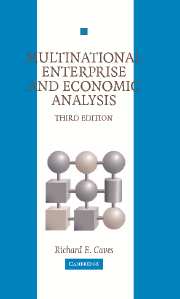Book contents
- Frontmatter
- Contents
- Preface
- 1 The Multinational Enterprise as an Economic Organization
- 2 The MNE and Models of International Economic Activity
- 3 Organization and Growth of the MNE
- 4 Patterns of Market Competition
- 5 Income Distribution and Labor Relations
- 6 Investment Behavior and Financial Flows
- 7 Technology and Productivity
- 8 Taxation, MNEs' Behavior, and Economic Welfare
- 9 Multinationals in Developing Countries and Economies in Transition
- 10 Public Policy
- Bibliography
- Name Index
- Subject Index
5 - Income Distribution and Labor Relations
Published online by Cambridge University Press: 18 December 2009
- Frontmatter
- Contents
- Preface
- 1 The Multinational Enterprise as an Economic Organization
- 2 The MNE and Models of International Economic Activity
- 3 Organization and Growth of the MNE
- 4 Patterns of Market Competition
- 5 Income Distribution and Labor Relations
- 6 Investment Behavior and Financial Flows
- 7 Technology and Productivity
- 8 Taxation, MNEs' Behavior, and Economic Welfare
- 9 Multinationals in Developing Countries and Economies in Transition
- 10 Public Policy
- Bibliography
- Name Index
- Subject Index
Summary
The multinational enterprise's relationship to wages and income distribution raises questions at two levels of analysis. In general equilibrium, the MNE reallocates capital between nations. That transfer can alter the income distribution within the source and host countries. In the individual industry (partial-equilibrium analysis), the MNE can affect the labor-management bargain. We shall take up these two levels of analysis in turn; the concluding section will suggest some propositions about the relationship between them.
Income Distribution in General Equilibrium
In the early 1970s, U.S. labor unions campaigned strenuously to restrict foreign investment by U.S. corporations, in the name of saving American jobs. Nearly two decades later Glickman and Woodward (1989) argued that, while U.S. investment abroad destroys American jobs, foreign MNEs' investments in the United States do not create very many. Similar issues arise periodically in other countries, as in Japan's concern in the 1980s that foreign investment was “hollowing out” its manufacturing sector. Economic analysis does not accept the popular view that foreign investment permanently changes the level of unemployment, but it does affirm that short-run changes in unemployment and permanent changes in real wages can result. Exactly what changes are predicted depends sensitively on assumptions about the nature of direct investment and the structure of the economy. We start with the long-run effects on income distribution and wages and then treat employment effects as their short-run counterparts.
Theoretical Models
International-trade theory offers several models that relate international factor movements to the distribution of income.
- Type
- Chapter
- Information
- Multinational Enterprise and Economic Analysis , pp. 137 - 160Publisher: Cambridge University PressPrint publication year: 2007



